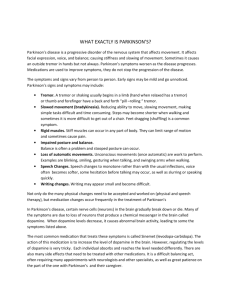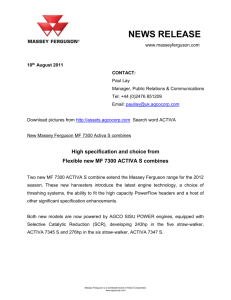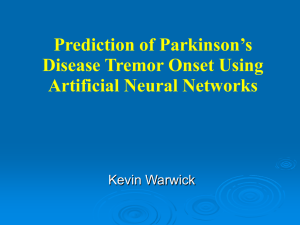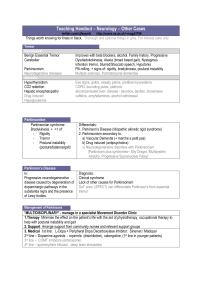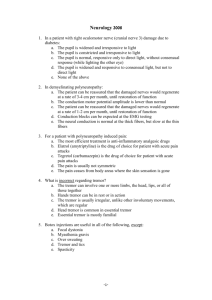Activa DBS Therapy Overview. ppt
advertisement
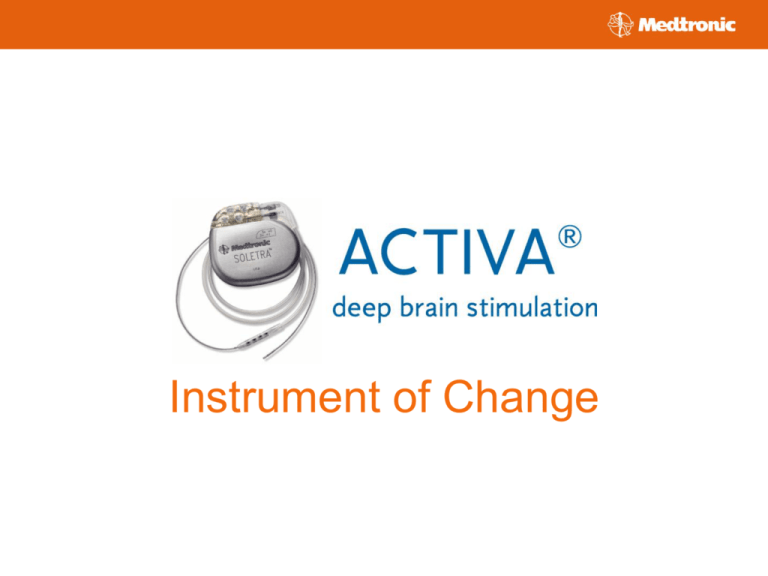
Instrument of Change Activa Therapy: Improving Motor Function for Movement Disorder Patients Double click box to play video Activa Therapy • Overview • Approved Indications for Activa Therapy – Parkinson’s disease – Essential Tremor – Dystonia • Surgical Procedure • Patient Management • Coding and Reimbursement • Activa in Your Practice Activa Therapy: Overview Activa Therapy • Also known as deep brain stimulation, or DBS • Uses an implanted electrode to deliver high-frequency electrical stimulation to structures involved in the control of movement within either the: – Ventral intermediate nucleus of the thalamus (Vim) – Subthalamic nucleus (STN) – Globus pallidus (GPi) • This electrical stimulation overrides abnormal neuronal activity within these brain regions to bring motor controlling circuits into a more normal state of function, thereby reducing movement disorder symptoms Double click image to play video Approved Indications • Activa Therapy is approved for the treatment of symptoms due to: – Essential Tremor • FDA approved in 1997 – Parkinson’s disease • FDA approved in 2002 – Dystonia • FDA approved (HDE*) in 2003 • Over 30,000 patients implanted worldwide *Humanitarian Device: Authorized by Federal Law for the use as an aid in the management of chronic, intractable (drug refractory) primary dystonia, including generalized and segmental dystonia, hemidystonia, and cervical dystonia, for individuals 7 years of age and older. Target Sites for Activa Therapy Vim Thalamus: Essential Tremor Subthalamic Nucleus: Parkinson’s disease and Dystonia Globus Pallidus: Parkinson’s disease and Dystonia Activa Therapy: Implantable Components • Lead • Extension • Neurostimulator (implantable pulse generator) Soletra™ Single Channel Output Kinetra® Dual Channel Output External Components 8840 N’Vision® Clinician Programmer Access™ Patient Controller Access™ Review Patient Controller Activa Therapy: Parkinson’s Disease Parkinson’s Disease • Progressive neurodegenerative disorder with the cardinal features of: – Bradykinesia/akinesia – Tremor – Rigidity – Postural instability • Second most common neurodegenerative disorder, affecting more than 1 million Americans Treatments for PD • Pharmacological treatments • Supplemental therapies – Physical therapy – Speech therapy – Environmental modification • Surgical interventions – Activa Therapy (DBS) – Ablation Activa Therapy Improves Some of the Cardinal Motor Features of PD Double click box to play video Parkinson’s Disease Treatment: Continuum of Interventions Disease Severity Mild Signs of levodopa “wearing-off” Patient Symptoms Treatment Moderate Agonists Levodopa, COMT inhibitors, others Modified from Giroux, ML and Farris, SF. Cleveland Clinic Foundation 2005 Cleveland Clinic Foundation Center for Neurological Restoration Severe Dyskinesia, “On-Off” Motor Fluctuations DBS Postural Instability, Freezing, Falls, Dementia Activa Therapy: When Pharmacotherapy isn’t Enough • As Parkinson’s disease progresses, medications may fail to provide consistent and adequate symptom control • Medications used at levels required for symptom control may produce adverse effects – Motor complications, such as dyskinesia – Cognitive and psychiatric problems – Nausea, hypotension, and other systemic effects When Should Activa be Considered? • When, despite optimized pharmacotherapy, your patient experiences troubling motor symptoms, which may include: – Wearing off – Off periods that contain troubling bradykinesia, rigidity, tremor, and/or gait difficulty – Troubling dyskinesia – Motor fluctuations – Refractory tremor Exclusion Criteria for Activa • Atypical (non-idiopathic) parkinsonism • Lack of sustained response to levodopa • Frank dementia, moderate to severe dementia Most Activa Implanting Centers will review patient medical history to identify other potential exclusion criteria & verify patient candidacy for Activa. Two Questions to Ask Your Patient: • “How many hours a day do your symptoms bother you?” • “Are you satisfied?” – If they aren’t satisfied with their symptom control using existing therapy, Activa should be considered “ON” Time Without Dyskinesias Improves from 27% to 74% of a Patient’s Waking Day* 19% 27% 7% 49% 74%* 23% Before Surgery (n=96) ‘ON’ with Dyskinesia 6 Months After Surgery Bilateral STN Activa® Implant (n=91) ‘ON’ without Dyskinesia * The Deep-Brain Stimulation for Parkinson’s Disease Study Group. Deep-brain stimulation of the subthalamic nucleus for the pars interna of the globus pallidus in Parkinson’s disease. N Eng J Med. 2001;345:956-63. ‘OFF’ Efficacy: Benefits of Activa Therapy Impact on Mobility Dyskinesia Before “On” Time After “Off” Time This graph is only for illustrative purposes and does not represent actual “on” and “off” time. Efficacy: Benefits of Activa Therapy for PD Patient Population 87% of patients demonstrated improved motor scores in the OFF medication state at the 12month evaluation .* * Results were for a subset of patients whose data were verified against medical records. Data on file at Medtronic, Inc. Motor Symptoms Improvements Maintained After 5 Years • In a 5-year study, ACTIVA significantly improved OFF-medication assessments of tremor, rigidity, and akinesia/bradykinesia OFF-Medication Motor Score Improvements* 6-month 1-year 3 years 5 years Tremor 79% 75% 83% 75% Rigidity 58% 73% 74% 71% Akinesia 42% 63% 52% 49% *Results for STN Additional Benefits of Activa • Bilateral, reversible, and adjustable • Non-destructive versus ablative procedures • Can be non-invasively fine-tuned to each patient’s individual needs Activa Therapy: Potential Complications and Risks • Surgery related – Hemorrhage (inherent in any stereotactic procedure); may be silent or symptomatic – Transient confusion – Infection (typically occurs at neurostimulator site in chest when it does occur) • Stimulation related – Usually can be minimized or eliminated by adjusting stimulation settings – Reversible paresthesia, dysarthria, muscle contraction Activa Therapy: Essential Tremor Essential Tremor • The most common movement disorder, affecting up to 20% of the elderly • Produces postural tremor disorder (may also occur at rest); most commonly affects hands but can also affect head, voice, tongue, and legs Pharmacologic Treatment of ET • Beta-blockers • Antiepileptics • Benzodiazepines • Botulinum toxin injections • Drug-induced adverse effects common Questions to Ask Your Patient: • "How many hours per day do your symptoms bother you?" • “Are you satisfied with your ability to do the things you enjoy?” Video: ET Patient Before & After Pre-Op Comparing Pre & Post-Op Double click box to play video Double click box to play video Activa Therapy Efficacy for ET • 69% of Essential Tremor patients experience total or significant suppression of disabling tremor * – This results in significant reduction in disability • Stimulation-induced adverse effects include transient paresthesia, dysarthria, and disequilibrium – Many of the side effects were temporary or improved with adjustment of electrical parameters * Data on File. Medtronic, Inc. Essential Tremor Guidelines • Guidelines published by the American Academy of Neurology (AAN) in June 2005 concluded that: – Unilateral DBS resulted in a significant (60 to 90%) reduction of contralateral limb tremor Zesiewicz TA, Elbe R, Louis ED, et al. Practice Parameter: Therapies for essential tremor. Report of the Quality Standards Subcommittee of the American Academy of Neurology. Neurology 2005;64:2008-2020 Activa Therapy: Dystonia Pre-Op Dystonia Video Double click box to play video Double click box to play video Post-Op Long Term Double click box to play video Post-Op Short Term Dystonia • Syndrome of sustained muscle contractions, frequently causing twisting and repetitive movements, or abnormal postures • Onset: Mean age = 27, with bimodal incidence peaks at 9 and 40 years of age • Dystonic symptoms may be increased with movement Pharmacologic Treatment of Dystonia • Anticholinergics • Dopaminergic agents • Benzodiazepines • Baclofen • Local injections of botulinum toxin Activa Therapy for Dystonia • Currently approved under Humanitarian Device Exemption (HDE) *Humanitarian Device Exemption approval for patients 7 years and older Key DBS Literature Parkinson's disease • The Deep-Brain Stimulation for Parkinson’s Disease Study Group. Deep-brain stimulation of the subthalamic nucleus for the pars interna of the globus pallidus in Parkinson’s disease. N Eng J Med. 2001;345:956-63. • Krack P, Batir A, Van Blercam N, et al. Five-year follow-up of bilateral stimulation of the subthalamic nucleus in advanced Parkinson’s disease. N Eng J Med. 2003;349:1925-1934. Essential Tremor • Koller WC, Lyons KE, Wilkinson SB, et al. Long-term safety and efficacy of unilateral deep brain stimulation of the thalamus in essential tremor. Mov Disord. 2001 May;16(3):464-8. Dystonia • Coubes P, Roubertie A, Vayssiere N, et al. Treatment of DYT1-generalised dystonia by stimulation of the internal globus pallidus. Lancet 2000;355:2220 Activa Therapy: Surgical Procedure Surgical Technique – Stereotactic frame placement or frameless stereotaxy – Targeting • Imaging • Stereotactic targeting • Physiologic targeting (microelectrode recording and stimulation) – Electrode placement – Pulse generator implantation Surgical Technique: Targeting • Sophisticated imaging and software enables precise targeting for optimal outcomes and minimal risk • Microelectrode recording (MER) offers additional levels of verification of lead location Surgical Technique: Microelectrode Recording Border 10sec 80ms STN 10sec 80ms Border/SN 10sec 80ms Sagittal Section Through the Thalamus Surgical Technique: DBS Lead Placement • Leads placed in motor territory of nucleus • Leads have four electrodes • Multiple electrode configurations possible during post-operative programming Target Sites for Activa Therapy Vim Thalamus: Essential Tremor Subthalamic Nucleus: Parkinson’s disease and Dystonia Globus Pallidus: Parkinson’s disease and Dystonia Surgical Technique: Neurostimulator Placement • Can be done immediately or days/weeks later • Typically placed below clavicle • Connected to lead using extension Activa Patient Management Adjustability of Activa Therapy • Non-invasive adjustment of parameters to maximize benefit and minimize adverse effects • Selection of electrodes allows adjustment of the site of stimulation • Adjustment of parameters allows control over amount of therapy • Adjustments generally are few once optimal parameters are achieved Coding & Reimbursement Commonly Billed Codes Neurologist Physician Coding & Reimbursement for Programming Code Description 2005 Medicare National Avg. in Office Setting 2005 Medicare National Avg. in Outpatient Setting 95970 Electronic analysis of IPG, without reprogramming $50.40 $23.50 95978* Electronic analysis of deep brain IPG with programming, 1st hour $212.60 $188.73 95979* Electronic analysis of deep brain IPG with programming, each add’l 30 minutes after 1st hour $98.15 $91.33 *CPT 95972 & 95973 are reassigned to CPT 95978 & 95979 for 2005, specifically for the analysis & reprogramming of a deep brain neurostimulator pulse generator. 2005 Medicare National Payment based on 2005 Medicare RVUs and conversion factor ($37.8975) as published in the November 3, 2004 Federal Register. Individual physician reimbursement will vary. High Volume Neurology Codes Code Description 2005 Medicare Fee Schedule Average Time (minutes) Revenue per Hour Procedures 95903 Motor NCT $69.73 30-60 $70-139 95816 EEG $187.59 30-60 $188-375 95860 Needle EMG $92.85 15-30 $186-371 95974 VNS Programming and Analysis $184.56 10-20 $554-1107 95978 DBS Programming and Analysis $212.61 15-60 $213-850 This table compares revenue and time utilization for high volume neurology patient care and codes. The time and revenue will vary based on variances in clinical practice. Activa in Your Practice • Establish how you want to work with the Activa center in your area • Partner with Medtronic to develop a training program for you and your staff • Identify, educate, and refer appropriate patients Working with the Activa Center • Become familiar with the center where you will refer patients for Activa Therapy – Your Medtronic Therapy Consultant will assist you in meeting members of the local Activa center • Determine your desired role in working with Activa patients – Participate in post-implant management of Activa Therapy (programming the device) – Refer for implant, with Activa center managing stimulation programming; continue to manage non-Activa issues • View an Activa Therapy system surgical implant or programming clinic Training for You and Your Staff • Partner with Medtronic for a full range of educational opportunities designed to further your therapeutic success • Medtronic Activa Therapy’s Curriculum For Life provides the framework to support your professional growth as you develop and expand your expertise • www.activauniversity.com Building a Curriculum and Designing a Pathway for Success Toward Lifelong Learning Identify, Educate, and Refer Appropriate Patients • Medtronic can support you with patient education materials • Activa Ambassador – Gives patients the opportunity to consult and interact with an implanted patient • Introduction to Activa Event – Physician-directed patient events designed to identify Activa candidates Activa Therapy is Rewarding Sooner Can be Better than Later “…stimulation therapy should be considered . . . before the development of a major disability that threatens their employment and their roles in their family and in society.” AE Lang. Subthalamic Stimulation for Parkinson’s Disease – Living Better Electrically? N Engl J Med 2003;1888-91. Disclosure Statement/Contraindications Indications: Parkinson’s Control Therapy: Bilateral stimulation of the internal globus pallidus (GPi) or the subthalamic nucleus (STN) using Medtronic® Activa® Parkinson’s Control Therapy is indicated for adjunctive therapy in reducing some of the symptoms of advanced, levodopa-responsive Parkinson’s disease that are not adequately controlled with medication. Tremor Control Therapy: Unilateral thalamic stimulation by the Medtronic® Activa® Tremor Control System is indicated for the suppression of tremor in the upper extremity. The system is intended for use in patients who are diagnosed with Essential Tremor or Parkinsonian tremor not adequately controlled by medications and where the tremor constitutes a significant functional disability. The safety or effectiveness of this therapy has not been established for bilateral stimulation. Dystonia Therapy: Unilateral or bilateral stimulation of the internal globus pallidus (GPi) or the subthalamic nucleus (STN) by the Medtronic Activa System is indicated as an aid in the management of chronic, intractable (drug refractory) primary dystonia, including generalized and segmental dystonia, hemidystonia, and cervical dystonia (torticollis), for individuals 7 years of age and older. Contraindications: Contraindications include patients who will be exposed to MRI using a full body radio-frequency (RF) coil or a head transmit coil that extends over the chest area, patients who are unable to properly operate the neurostimulator, or for Parkinson’s disease and Essential Tremor, patients for whom test stimulation is unsuccessful. Also, diathermy (e.g., shortwave diathermy, microwave diathermy or therapeutic ultrasound diathermy) is contraindicated because diathermy's energy can be transferred through the implanted system (or any of the separate implanted components), which can cause tissue damage and can result in severe injury or death. Diathermy can damage parts of the neurostimulation system. Disclosure Statement/Contraindications Warnings/ Precautions/Adverse Events: There is a potential risk of tissue damage using stimulation parameter settings of high amplitudes and wide pulse widths. Extreme care should be used with lead implantation in patients with a heightened risk of intracranial hemorrhage. Do not place the lead-extension connector in the soft tissues of the neck. Placement in this location has been associated with an increased incidence of lead fracture. Theft detectors and security screening devices may cause stimulation to switch ON or OFF, and may cause some patients to experience a momentary increase in perceived stimulation. Although some MRI procedures can be performed safely with an implanted Activa System, clinicians should carefully weigh the decision to use MRI in patients with an implanted Activa System. MRI can cause induced voltages in the neurostimulator and/or lead possibly causing uncomfortable, jolting, or shocking levels of stimulation. MRI image quality may be reduced for patients who require the neurostimulator to control tremor, because the tremor may return when the neurostimulator is turned off. Severe burns could result if the neurostimulator case is ruptured or pierced. The Activa System may be affected by or adversely affect medical equipment such as cardiac pacemakers or therapies, cardioverter/defibrillators, external defibrillators, ultrasonic equipment, electrocautery, or radiation therapy. Safety and effectiveness has not been established for patients with neurological disease other than Parkinson’s disease or Essential Tremor, previous surgical ablation procedures, dementia, coagulopathies, or moderate to severe depression; or for patients who are pregnant, under 18 years, over 75 years of age (Parkinson’s Control Therapy) or over 80 years of age (Tremor Control Therapy). For patients with Dystonia, age of implant is suggested to be that at which brain growth is approximately 90% complete or above. Additionally, the abrupt cessation of stimulation for any reason should be avoided as it may cause a return of disease symptoms. In some cases, symptoms may return with an intensity greater than was experienced prior to system implant (“rebound” effect). Adverse events related to the therapy, device, or procedure can include: stimulation not effective, cognitive disorders, pain, dyskinesia, dystonia, speech disorders including dysarthria, infection, paresthesia, intracranial hemorrhage, electromagnetic interference, cardiovascular events, visual disturbances, sensory disturbances, device migration, paresis/asthenia, abnormal gait, incoordination, headaches, lead repositioning, thinking abnormal, device explant, hemiplegia, lead fracture, seizures, respiratory events, and shocking or jolting stimulation. Humanitarian Device: Authorized by Federal Law for the use as an aid in the management of chronic, intractable (drug refractory) primary dystonia, including generalized and segmental dystonia, hemidystonia, and cervical dystonia (torticollis), for individuals 7 years of age and older.
